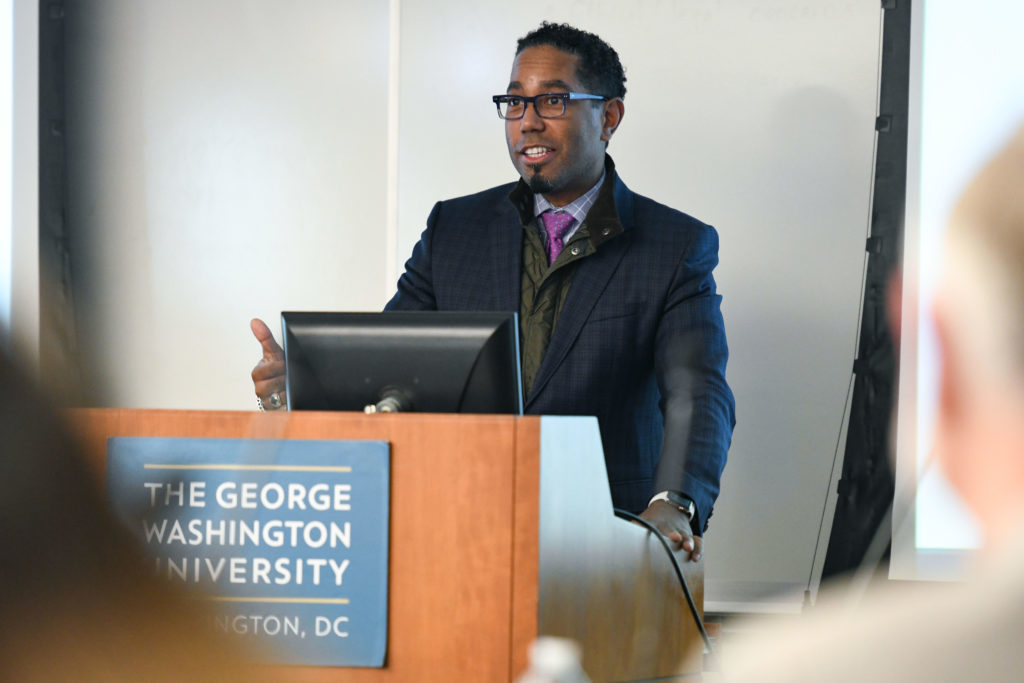All 10 of GW’s deans will be put under a microscope in a new faculty review process.
In a presentation to the Faculty Senate earlier this month, Vice Provost for Faculty Affairs Christopher Bracey said officials have implemented a new evaluation process – created last academic year by a faculty advisory committee – that includes students, faculty, staff and alumni input. Bracey said the new process is designed to allow for a broad overview of a dean’s performance, giving all groups involved an outlet to comment on the leadership of their school.
David Dolling, the dean of the School of Engineering and Applied Sciences, was the first dean to be evaluated under the new process. His review wrapped up this month, Bracey said.
The reviews, which include a combination of in-person meetings and online surveys, will take place at least once every three years, a timeframe mandated in the changes to faculty governing rules enacted in 2015.
“We want to make sure that we are getting their input.”
The review process for each dean begins when Bracey or Provost Forrest Maltzman meets with dean’s councils, faculty and staff to gather input about what issues and questions the survey should address for their specific school.
“It’s a briefing session but it’s also a strategy session,” he said. “We want to make sure that we are getting their input.”
The provost’s office will then submit a survey asking a sample of faculty, staff, students and alumni in each school whether a dean is developing a vision for the school, collaborating effectively with administrators, encouraging input in their decision-making, managing efficiently and communicating expectations regarding tenure and promotions, Bracey said.
“What we are really doing is asking whether or not the deans do it right when thinking about developing a vision or direction for the school,” he said.
The provost will also host in-person feeback sessions with faculty and the deans as part of the “data-collection stage,” Bracey said.
Once all of the data is collected, the provost will provide a “summary of the general conclusion” to the faculty. Only the dean, provost, University president and Board of Trustees will receive full details of the final evaluation, Bracey said.
The summary of Dolling’s review – which began last semester and ended earlier this month – has been shared with SEAS faculty, he said.
Bracey said officials were satisfied with the level of participation in the survey, which is always one of the main challenges of these types of reviews. Of those given the survey in SEAS, 71 percent of faculty, 100 percent of staff, 40 percent of students and 60 percent of alumni responded. The actual results of the survey were not shared at the meeting.
“We believe that the review and transparency were well-received by the faculty,” Bracey said.
Data is currently being collected for Dean Ben Vinson of the Columbian College of Arts and Sciences. Bracey said participation rates look promising at about 55 percent, but officials hope to increase that rate.
Reviews will begin for the deans of the Milken Institute School of Public Health and the School of Medicine and Health Sciences this spring. The deans of the law school and the Graduate School of Education and Human Development will follow in fall 2018, and in spring 2019 the deans of the Elliott School of International Affairs and School of Nursing will be evaluated.
Following Bracey’s presentation, some members of the Faculty Senate voiced concerns that the surveys may not be completely anonymous, potentially impacting the feedback faculty, students and staff are willing to submit.
Philip Wirtz, a professor of decision sciences and psychology and chair of the senate’s educational policy committee, said each faculty member fills out the survey from a computer with a unique, traceable IP address, making the survey “about as far from anonymous as it could be.”
“There is a role for anonymity and there is a role for open, frank talk.”
“It most certainly does not guarantee anonymity,” he said of the new process. “While I certainly understand that there were a number of faculty willing to offer their views without that, it’s actually the ones who would like it to be totally anonymous that I would value most.”
Wirtz said he and his colleagues are concerned that the provost is the only person with access to the full data and that while he doesn’t have concerns with Maltzman, future administrators may use the information from the surveys improperly.
“It puts the responsibility entirely on the provost. We do have something here where we are setting a precedent for the future and we don’t know who the future provosts are going to be,” he said.
To address these concerns, Bracey said in an email last week that officials will now allow faculty to submit a hard copy instead of the online survey.
University President Thomas LeBlanc said at the meeting that while he understands the concerns over anonymity, he doesn’t think it is constructive for all information to come from an anonymous source.
“There is a role for anonymity and there is a role for open, frank talk,” he said at the meeting. “I hope the process can allow for both.”
Liz Konneker contributed to reporting.





